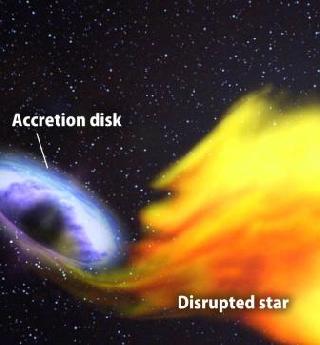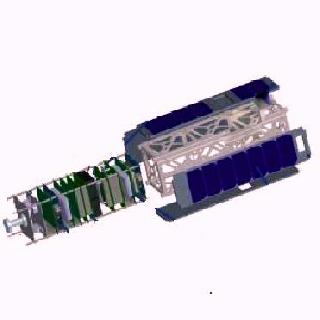
An illustration of a sun-like star on an eccentric orbit plunges too close to its galaxy's central black hole. Photo by NASA/Goddard Space Flight Center/CI Lab.
WASHINGTON (BNS): Researchers have provided new insights into a cosmic accident that has been streaming X-rays toward Earth since late March.
NASA's Swift satellite first alerted astronomers to intense and unusual high-energy flares from the new source in the constellation Draco.
"Incredibly, this source is still producing X-rays and may remain bright enough for Swift to observe into next year," said David Burrows, lead scientist for the mission's X-Ray Telescope instrument.
Astronomers said the source, known as Swift J1644+57, was the result of the awakening of a distant galaxy's dormant black hole as it shredded and consumed a star. The galaxy is so far away, it took the light from the event approximately 3.9 billion years to reach Earth.
According to two new studies published in the journal Nature, the black hole in the galaxy hosting Swift J1644+57 may be twice the mass of the four-million-solar-mass black hole in the center of the Milky Way galaxy.
As a star falls toward a black hole, it is ripped apart by intense tides. The gas is corralled into a disk that swirls around the black hole and becomes rapidly heated to temperatures of millions of degrees. The innermost gas in the disk spirals toward the black hole, where rapid motion and magnetism create dual, oppositely directed "funnels" through which some particles may escape.
Jets driving matter at velocities greater than 90 percent the speed of light form along the black hole's spin axis. In the case of Swift J1644+57, one of these jets happened to point straight at Earth.
When first detected on March 28, the flares were initially assumed to signal a gamma-ray burst but as the emission continued to brighten and flare, astronomers realized that the most plausible explanation was the tidal disruption of a sun-like star seen as beamed emission.
 Previous Article
Previous Article Next Article
Next Article












The Indian Air Force, in its flight trials evaluation report submitted before the Defence Ministry l..
view articleAn insight into the Medium Multi-Role Combat Aircraft competition...
view articleSky enthusiasts can now spot the International Space Station (ISS) commanded by Indian-American astr..
view article